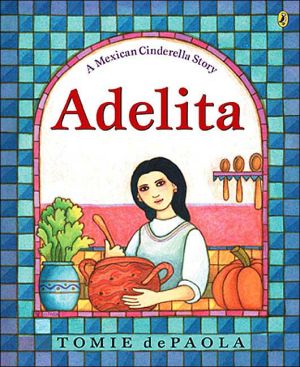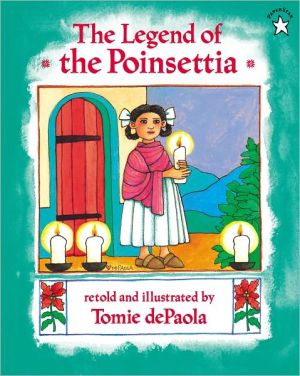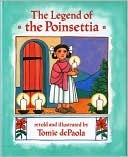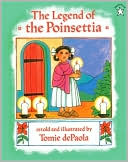Adelita: A Mexican Cinderella Story
Hace mucho tiempo?a long time ago?there lived a beautiful young woman named Adelita. So begins the age-old tale of a kind-hearted young woman, her jealous stepmother, two hateful stepsisters, and a young man in search of a wife. The young man, Javier, falls madly in love with beautiful Adelita, but she disappears from his fiesta at midnight, leaving him with only one clue to her hidden identity?a beautiful rebozo? shawl. With the rebozo in place of a glass slipper, this favorite fairy tale...
Search in google:
Hace mucho tiempo—a long time ago—there lived a beautiful young woman named Adelita. So begins the age-old tale of a kind-hearted young woman, her jealous stepmother, two hateful stepsisters, and a young man in search of a wife. The young man, Javier, falls madly in love with beautiful Adelita, but she disappears from his fiesta at midnight, leaving him with only one clue to her hidden identity—a beautiful rebozo— shawl. With the rebozo in place of a glass slipper, this favorite fairy tale takes a delightful twist. Tomie dePaola's exquisite paintings, filled with the folk art of Mexico, make this a Cinderella story like no other.Publishers WeeklyThere's no pumpkin coach or glass slipper in sight, but Cinderella fans will find much to like in dePaola's (26 Fairmount Avenue) original twist, infused with Mexican warmth and color. Following her father's sudden death, Adelita is left to suffer the abuse of her cruel stepmother and stepsisters. Adelita's kindly nanny/housekeeper takes on the role of fairy godmother, making certain that the girl has something to wear to the party thrown by a local wealthy family to honor their (eligible bachelor) son, Javier. Adelita makes an unforgettable impression at the gala, draped in a dramatic red shawl that was her mother's; Adelita uses it to signal to Javier when he comes looking for her the next day. DePaola tweaks just enough details to make his version fresh; his liberal use of Spanish phrases (translated within the text) and cultural details enlighten as they enliven. He humorously winks at readers, too, by having his characters refer to the classic story ("All Do$a Micaela and her two daughters could talk about was `the mysterious Cenicienta' [Cinderella] who had appeared and then disappeared from the fiesta, just like the fairy tale"). His vibrant acrylics incorporate folk art motifs as well as rustic domestic items. The jazzy design features mosaic-like tile backgrounds of varying shades that frame smaller panels and portraits throughout. Ages 5-up. (Sept.) Copyright 2002 Cahners Business Information.
\ Publishers WeeklyThere's no pumpkin coach or glass slipper in sight, but Cinderella fans will find much to like in dePaola's (26 Fairmount Avenue) original twist, infused with Mexican warmth and color. Following her father's sudden death, Adelita is left to suffer the abuse of her cruel stepmother and stepsisters. Adelita's kindly nanny/housekeeper takes on the role of fairy godmother, making certain that the girl has something to wear to the party thrown by a local wealthy family to honor their (eligible bachelor) son, Javier. Adelita makes an unforgettable impression at the gala, draped in a dramatic red shawl that was her mother's; Adelita uses it to signal to Javier when he comes looking for her the next day. DePaola tweaks just enough details to make his version fresh; his liberal use of Spanish phrases (translated within the text) and cultural details enlighten as they enliven. He humorously winks at readers, too, by having his characters refer to the classic story ("All Do$a Micaela and her two daughters could talk about was `the mysterious Cenicienta' [Cinderella] who had appeared and then disappeared from the fiesta, just like the fairy tale"). His vibrant acrylics incorporate folk art motifs as well as rustic domestic items. The jazzy design features mosaic-like tile backgrounds of varying shades that frame smaller panels and portraits throughout. Ages 5-up. (Sept.) Copyright 2002 Cahners Business Information.\ \ \ \ \ School Library JournalK-Gr 3-In this folktale variant, lovely Adelita gains a family when her father remarries. Following the traditional story line, Dona Micaela and her daughters, Valentina and Dulce, are utterly impossible, but all is well as long as Adelita's father is alive. However, when he dies, she is relegated to helping in the kitchen. Eventually, Dona Micaela evicts old Esperanza, and her stepdaughter is left to do all the work. On the night of the fiesta at the Gordillos' hacienda, it is Esperanza who takes the fairy godmother role, sends Adelita to the party, and sees to it that young Javier is smitten. True to form, he locates the young woman when she flees, and they marry. The prose is straightforward and crisp, though the habit of including a Spanish phrase that is translated immediately afterward (e.g., "Soy yo-only me-" or "-mi peque-ita-my little one-") interrupts the narrative flow. However, this is a minor quibble given the beauty of dePaola's signature artwork. Making perfect use of clear, warm hues, the full-color acrylic illustrations are a feast for the eye. Depth and brilliance in composition combine with economy of line and form to create a true tour de force. Use this with either Robert D. San Souci's Little Gold Star (HarperCollins, 2000) or Joe Hayes's Little Gold Star/Estrellita de oro (Cinco Puntos, 2000) for different looks at "Cinderella" through Mexican eyes.-Ann Welton, Grant Elementary School, Tacoma, WA Copyright 2002 Cahners Business Information.\ \ \ Kirkus ReviewsPlacing this Cinderella variation in upper-class Mexico in the last century, dePaola (A New Barker in the House, p. 409, etc.) has framed the story in a more realistic vein than usual. There are no magical elements, yet the prolific author-illustrator weaves together a very satisfying tale of the beautiful and good Adelita and her sweet young man, Javier, a childhood friend. The fairy godmother is a faithful servant who has always worked for the Mercado family. The dress belonged to Adelita's mother and instead of the glass slipper, Adelita uses her beautiful rebozo, a shawl covered in birds and flowers, to lead her rich young gentleman back to her after she leaves the fiesta early. The human relationships remain the same: the evil stepmother and the selfish stepsisters are depicted here in the usual way, yet kindly Adelita invites them all to her wedding at the end. Esperanza, the servant who quietly manages to bring an end to Adelita's sufferings, brings a cart to take her to the hacienda, not a coach made out of a pumpkin. Spanish phrases and their translations are used throughout the text and a list providing pronunciations is given at the end. The acrylic paintings are handsome and dignified, with borders of Mexican tile and many archways giving a graceful unity to dePaola's signature characters. The rich colors change in tone as sad times, mourning, and great happiness are all depicted in different double-page spreads. The endpapers explode with the lively pattern of the all-important rebozo. Decorative objects, including religious items, pottery, Mexican crafts, and kitchenware give the illustrations an authentic touch. Heartwarming, but not sappy, this version will lead youngwriters off in many directions as they write their own Cinderella tales in locations of their own choosing. An enjoyable read-aloud, this is a fine addition to the author's growing collection of stories set in Mexico. (Picture book. 6-10)\ \



